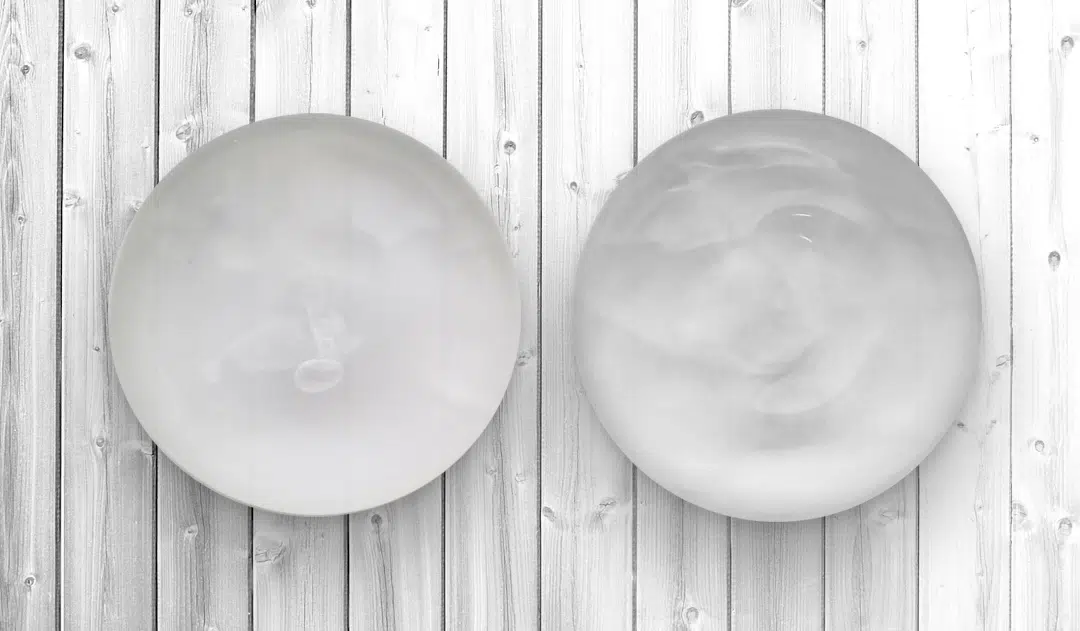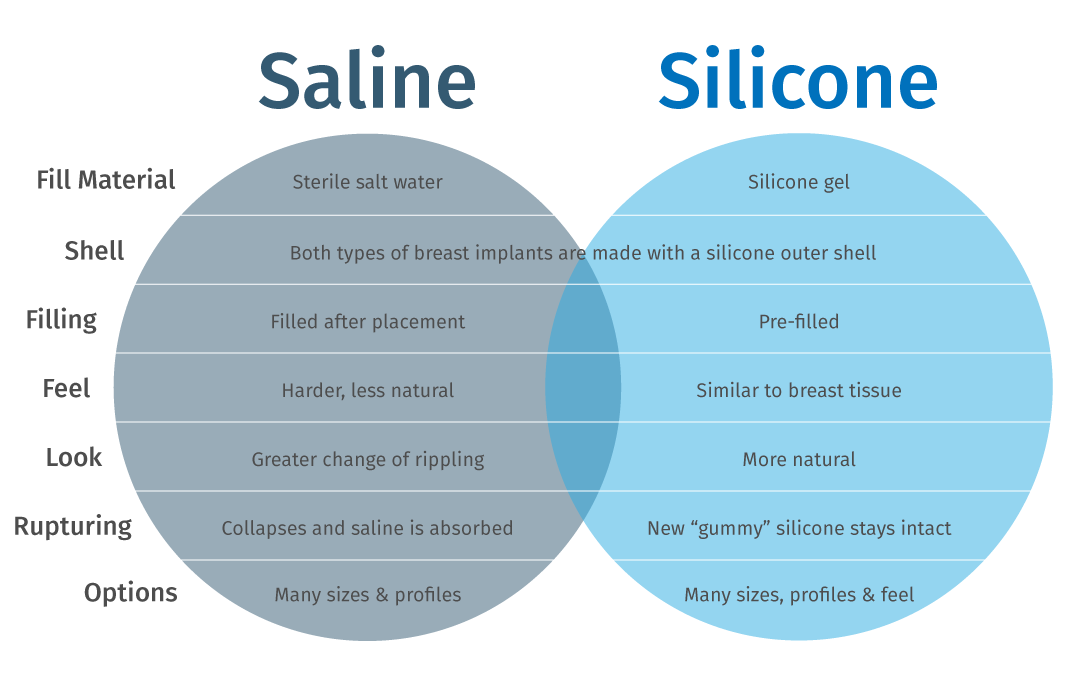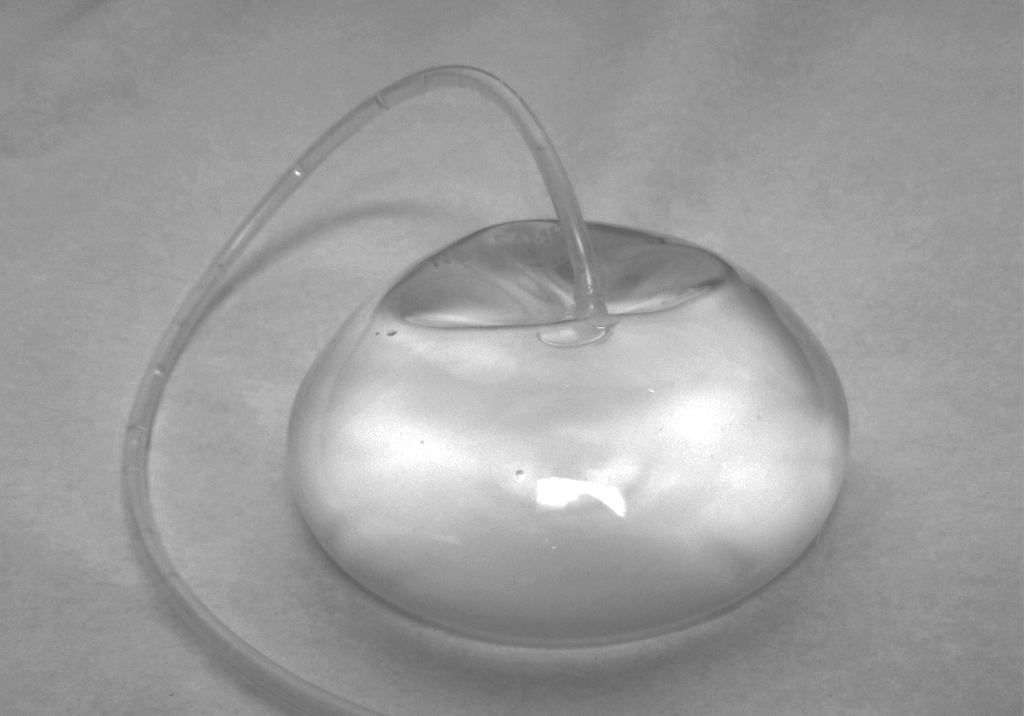What is the difference between saline and silicone implants?
Everything you need to know when choosing breast implant fill types. Understand the differences between saline and silicone implants.
Everything you need to know when choosing breast implant fill types. Understand the differences between saline and silicone implants.

When you’re considering getting a breast augmentation done, you have so many choices to make. Which surgeon should you see, what size do you want, and, of course, whether you should get saline or silicone breast implants. Let’s start by talking about the all-important question of saline or silicone. Although this topic isn’t as controversial as it used to be, it’s still a good idea to review the topic so you know what you’re getting into when deciding between the two.
All breast implants will enlarge and enhance your breasts. Practically all breast implants have a silicone shell which can be smooth or textured. The difference is in what fills these implants. You can think of it as a donut. Donuts can have the same dough outside but the filling can be jelly-filled or custard-filled.
One material used to fill the shell is saline, which has the consistency of water. Another fill material is silicone, which is a thicker substance. Saline and silicone gel implants also come in different shapes and sizes which determine the projection of your implants, but the overall look and feel really comes down to what’s inside.

Saline implants are filled with a sterile, salt-water solution called saline. You’ve probably heard of saline solution because it’s what people use with their contact lenses. These implants are hollow, and filled inside the chest during your procedure, kind of like a water balloon.
The main advantage of saline implants is if the shell develops a hole that allows the saline to leak, the saline solution is harmless. The composition of saline is similar to many of your body’s own fluids, so it’s easily and safely absorbed and expelled.1 The implant usually deflates right away and you will suddenly see a much smaller breast.
Another advantage is that saline implants only need a small incision. The surgeon makes a small incision, then rolls the empty saline implant into a shape similar to a cigar. After that, it is placed inside the chest cavity and the implant is filled with saline. This enables saline incisions to be slightly shorter than silicone incisions, especially for larger implant sizes.2 This also means that saline implants can be individually filled with customized amounts of fluid.

The disadvantages of having saline implants is that they just don’t look and feel like natural breast tissue. That’s because saline implants are essentially water balloons and natural breast tissue is not filled with water. Natural breast tissue is more like the consistency of fat, only denser. On some women with especially thin skin, saline implants can cause rippling. Rippling looks kind of like stretch marks and is especially severe when you look at the sides of the breast when you are bending over. Now, to be fair, you can get rippling with silicone, too, but saline will be significantly worse.
Think of your skin as being like a piece of paper. When you have thin skin, it’s like having tissue paper. The tissue paper is thin, so you can see everything underneath, like the ripples on the implant. If you have thicker skin or more fatty tissue, it’s like having cardboard. It’s harder to see the ripples because there is a thicker layer covering the implant.
Not only can saline breast implants be more visible, but they can also be more easily felt through thin tissue.3 Some women say that they can “feel the bag” of saline. The consistency of saline implants is more firm than natural breast tissue so saline usually feels a little harder, too.
Silicone implants are also sometimes called “gel” implants. Both terms mean the same thing. Silicone gel implants are filled with a thick gel substance that feels more like natural breast tissue.4
The gel filler in these implants comes in different levels of cohesivity. Cohesivity refers to how tightly stuck together the silicone molecules are. The more tightly they stick together, the higher the cohesivity, and the firmer the implant.5
It’s like the difference between runny pancake syrup versus thicker honey versus even more dense Jell-o.
Now, everyone’s heard of the new “gummy” implants. These next-generation implants have higher cohesivity than ever before, which means it’s also safer than ever before.6
The basic concept is that they’re like big gummy bears – if you cut a gummy bear in half, it doesn’t ooze everywhere. The shape of the bear stays pretty much the same. That’s the same case with these new silicone “gummy” implants. They maintain their shape so even if they rupture, you’re less likely to have silicone gel spreading into your tissues.

Simply put, silicone gel implants look more natural, and the gel consistency feels more natural, too. Another plus is that because of their cohesivity, silicone gel implants are better at keeping their shape even when you’re standing.7
This means that you’ll have more fullness on top, something many women are looking for, especially after having children.
Some women remember the “silicone scare” of the early 1990’s and still have concerns about the safety of silicone gel implants. After over a decade of researching the issue, it’s important to realize that the FDA concluded that there was no association between silicone implants and the connective tissue diseases they were concerned about.8
Silicone gel implants are safer than ever, and they’re only being improved as time goes on.
Remember how the shell of saline and silicone implants are the same? That means that both saline and silicone implants can form a leak. The difference is that when saline leaks, you can see the implant get smaller right away. With silicone, you probably wouldn’t notice if your implant leaked, since it wouldn’t lose its shape like a saline implant.9
The good news is that even if your silicone implants develop a hole, because they are gummy, the silicone filling inside will tend to stay intact.
Both saline and silicone implants should be monitored long-term. That means keeping in touch with your plastic surgeon, and, in the case of silicone implants, it is recommended to get periodic MRI’s (magnetic resonance imaging) to detect any changes with your implants.10
Since silicone gel implants are pre-filled, they may require a slightly longer incision to be placed. Depending on your own anatomy and the implant size you’ve decided on, an incision around your areola may not be possible. Although they can’t be individually-filled like saline implants, silicone implants are available in many sizes and can accommodate just about any body.
There are many characteristics that both saline and silicone share. By now, of course you know that both saline and silicone implants have the same silicone shell. They both come in a similar size range, meaning that no matter how small or big you want to go, either type will likely meet your needs. Both types also come in different shapes, so you can be sure that there’s something for every body type and personal preference.
Finally, breast implants are safer than ever, but they still shouldn’t be thought of as lifetime devices. It’s important to keep in touch with your plastic surgeon because there are several situations where you might want or need a re-operation. These include wanting to change to a different size (sometimes smaller, often bigger) or needing to due to leakage or capsular contracture (we explain more about capsular contracture here). Whether you’re thinking of saline or silicone implants, either implant will help you reach your personal goals. They’ll provide the fullness and shape that you’ve been looking for, so you can feel more beautiful than ever.
Most plastic surgeons’ offices will have samples of both the saline and silicone implants. Make sure you take time to feel the difference.
If you are in the Inland Empire or surrounding area, we would love to meet you. When you schedule a consultation appointment with one of our doctors and our patient care coordinator, you’ll have plenty of time to touch and feel the implants for yourself, thus ensuring that you’re making the best decision for you.